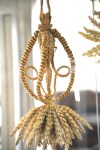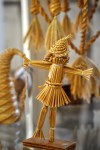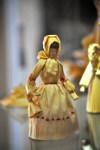Before steam, before automation, men and women worked hard on the land.
Everything must be done by hand, from milking to butter making to bringing in the corn. It was an unimaginably different life to the one we lead today, dictated by the ebb and flow of the seasons, the year broken up into light and dark, fruitful and barren, plentiful and sparse.
Personally, it is as far away from my own lifestyle as Neil Armstrong’s short sojourn on the moon. And that was brought home to me when I took a wander around our county town’s Museum of Rural Life.
Every exhibit there had once been a valued creation, passed down through families, many years before the advent of the throwaway society. Wood was one of the great plentiful, workable materials England had to offer its village communities. And people used it to make so much of the framework of their lives and work. I had no idea, until I wandered round this place.
I passed great rough-hewn Hardyesque wooden carts, made out of wooden beams, by hand. There were cart wheels, fashioned by carving a solid hub from a tree trunk and inserting hefty spokes and wheel sections. Every wall- even the ceiling – seemed covere in scythes and pitchforks, barrels and rough-whittled wooden chairs, every one handmade in a bygone age, every one unique.
And in a far corner of the museum, past the cheese presses and covered wagons, was a small glass cabinet of curiosities which must each have hung in a farm kitchen, keeping an old English spirit at bay during the long dark winter.
It’s not just us: it was a phenomenon in many countries that men would use scythes to harvest corn. Imagine, great fields of the stuff, having to be cut sheaf by sheaf, a labour taking many weeks. And the standing corn would become smaller and smaller, an entity in itself with its straight tall cliff-edge next to the stubble, creating stark-golden shadows in the setting sun. No wonder they said it held a spirit.
The story went that the spirit of the living corn retreated, away from the scythes, into the main body of corn, which got smaller and smaller as the weeks and days went on. The whole village would watch the standing corn dwindle, a different shape every day.
Until one day, there would be a final sheaf of corn to be cut. And in that, still hiding, was the spirit of the corn.
With the final sheaf, a corn doll – a corn hag, or a neck, a corn-mother, an old woman – was made. A little effigy, sometimes with human characteristics, was fashioned, woven intricately using the long corn-stalks.
Some were ploughed back into the corn the following Spring, an offering to the gods to render the field fertile.
But some hung for years in the farm kitchen.
Man is ambivalent towards his corn-hag. Some have said this was the same old hag who causes nightmares by sitting on the chest – called, these days – sleep paralysis. Some said the little women who held the spirit brought ill luck. But others saw it as a blessing of good fortune.
And so, occasionally, they were kept as family heirlooms. And a handful found their way to the little glass case in this place full of things made with infinite patience and the sweat of man.
Strange, to look at a little corn hag and think: you are hundreds of years old.
Does the Corn Spirit of your field still live there?
Written in response to Side View’s weekend theme: Family Heirlooms, which you can find here.







These are really cool. It reminds me of little woven straw angels I bought at a Christmas market in Germany.
They are quite similar, Steven!
I’m sure they do. Retiring every year into a warm andsafe place. Some of them being reborn with the corn every year, if they were ploughed back in.
What intriguing thoughts this offers 😉
Indeed, Sidey. There’s a story in there somewhere.
Wonderfully emotive piece. I’ve been on harvests in our little hamlet and there is something of this spirit that still endures here.
I’d have loved to have been present at the end of a harvest, Roger, just to watch that last sheaf disappear. The Cornish have a whole ritual that goes with it, the same words every year. Enchanting, if a little ‘Wicker Man’.
So interesting – again!
These are really absorbing little things, Julie.
Exquisitely woven talismans. I’ve always been partial to those featuring the heads of wheat. Maybe because in Oklahoma I grew up with wheat fields stretching to the horizon.
It’s a reminder of where they came from, isn’t it, PT?
Aren’t they beautiful? – and way more elaborate than any I’ve ever seen.
I know: it makes one wander how ever they made them. One must need to know how a stalk of wheat behaves; its exact breaking point.
They weaved magic with the last of the sheaves, as you have done in the telling of it.
Thank you, Col 🙂 They did weave magic. These are quite haunting objects up close.
Stateside the corn husk dolls originated with Native Americans, and are faceless today, because: http://voices.yahoo.com/the-importance-cornhusk-doll-native-culture-2606488.html Years ago one such doll resided in our home for a few years after my younger son made a school-sponsored trip here http://en.wikipedia.org/wiki/Conner_Prairie I’m not sure where she ended up, but I know we didn’t plow her under! 🙂
It’s amazing to me how often one of your posts triggers some long-forgotten thing or another for me! Thanks, yet again!
I have takn a long time to reply, though I read the story of thefaceless dolls almost straight away, Karen. Apologies.My Thursdays and Fridays are most muddled blogging-wise as they are my teaching days. Wonderful story – and the museum looks like a must-visit if I ever get over there!
I have never seen these before and now I think back to my farming days when combining the corn and wonder if I should have stopped and left that last stalk for good luck. Maybe that’s why the price we got for our corn was always lousy.
😀 Anything is possible, Lou. Though I suspect the Spirit of the Corn would have sidled up to your farmhouse and thought to itself: here will do nicely for the Winter.
I have, somewhere in a box full of childhood relics, a small collection of cornhusk dollies, very like the ones on the left of your sextet. I’ve no idea where they came from, but I did love them. It stands to reason they would survive here, though, as my part of the world draws it’s influences most noticeably from a native population who relied on corn and an English influx of hardworking settlers.
These dolls exist all over the world, with different stories and different superstitions, Cameron. Lovely to think the inspiration for yours might have come over the ocean from the fields of Dorset and Wiltshire.
A corn hag. Though not a very flattering name, certainly an interesting story. 🙂
Indeed. Hags have had a bad press, Carrie. Although I think they deserved some of it. And the word doesn’t help. Hag. Like your toothbrush has got stuck down your throat.
Ha! Good description.
Delightful post, Kate. I used to make yarn dolls in much the same fashion . . . in all colors of the rainbow.
Also loved the chair that appeared carved in one piece from a tree trunk! 😀
It was a gorgeous piece, Nancy, and all I wanted to do was the one thing which was not permitted: to sit on it. A lot of Scottish chairs were made from solid pieces of tree…
I remember the little Austrian crib that would come out each Christmas, A little key in the back wound a clockwork mechanism that played Stille Nacht, heilige Nacht. In the most delicate shaved wood was formed the shepherds, wise men, and crib, together with the star that led them there. Last Christmas I took the crib out of its box, and the star fell off. The passage of time I suppose…
Wonderful article as always
Everything must pass, I suppose, Laurence: but what a magical thing to possess.
I especially like the corn dragons. Very fanciful and enchanting. I like the old chair, too.
They are lovely things to wander round, Gail.
I had a modern version of a corn-hag quite a few years ago. She hung in my kitchen window until one day when I was cleaning and dusting the string holding her there broke. Rather than restring her I looked at her dusty, faded little figure and decided to toss her out. I’m glad now that there were people who held on to such things. Great post.
Thanks Kathy: yes, it’s good to save a few. They collect dust, though: not an easy thing to keep for a long time in a kitchen.
Goodness gracious, I have nothing useful to say except they are wonderful! Love your pictures!
Thanks, Katie 🙂
Corn hags I have and had a plenty. But not the kind from folklore.
‘Far away from my own lifestyle’ struck me funny, I guess am old. Puffs my chest, as a young 53, having grown up rural mouse, I have seen corn stooped, I know how to use a scythe, have made butter, maple syrup from sap. But I think I was born as an era was fading, The era when people knew a variety of skill and trades to survive. From my neighbour I learned how to attend beehives, to prune fruit orchards, how to assemble and carve rowing oars. From my father the list to long. With my parents, you did it yourself if you could as that was their upbring, only if in need did you hire it out. They too grew up rural, but they had grown up during the depression.
Living in Amish an Old Order Mennonite country, standing wheat sheaf, thrashing machines, wagon and spoke wheel makers can still be seen in practice, still supporting families that way it did in those museum days. Their children still make and play with corn dolls. But the spirit you talk about I think is close to extinction. There is hope when we have you to see and write about the value of that which is behind us.
Hudson, I wonder if it is not behind us, but just part of a cycle? We have not found a fuel yet which can possibly sustain the greedy old lifestyle many of us live. If there were no electricity again: you would be running the farm and teaching the skills to those who need them once again.
Come cataclysm, I’m heading your way.
Come cataclysm, am heading for the hills, see ya there. Don’t forget your heirlooms.
I’ll pack ’em in a sack and head on over.
I would have enjoyed this exhibit, I’m certain. I find tools and implements very satisfying. And I agree with you about the way these treasures were cared for and not so easily deemed disposable. But the corn hags really interest me, too. I’ve never heard of this before, and somewhere packed away with my childhood doll collection are a few of these cornhusk dolls. I never thought a thing about what they might represent. Now I’m eager to look at them again! Thank you, Kate. 🙂
Wow! You have some of these? I’d love to see some pictures if you ever get round to blogging them. It’s amazing what has survived over the years, isn’t it?
The custom of preserving the spirit of the field must be universal, because I remember similar tiny bunches of paddy at home. But nothing this elaborate or beautiful! The other exhibits are equally amazing!
So you have them out there too, Madhu? It shows that whilst mankind has its differences it has uncanny similarities too!
The straw dolls are intricate and beautiful.
We farmed a half-acre of the 66 we owned when I was a teen. How I looked forward to green beans and tomatoes fresh out of the field, and the many ways that my Mom could preserve those tomatoes for use in winter – spaghetti sauce, tomato juice, you name it.
Thanks, Kate, for reviving a great memory.
Pleasure, Judy. Thanks for sharing it: a golden one.
what a fanstastic post (as always). I think I will look differently at the little corn doll that I have 🙂